Transcription of 7 SAMPLING AND PREPARATION FOR LABORATORY …
1 7 SAMPLING AND PREPARATION FOR. LABORATORY MEASUREMENTS. Introduction There are three methods for collecting radiation data while performing a survey. A direct measurement is obtained by placing the detector near or against the surface or in the media being surveyed and reading the radioactivity level directly. Scanning is an evaluation technique performed by moving a portable radiation detection instrument at a constant speed and distance above the surface to semi-quantitatively detect elevated areas of radiation. These measurement techniques are discussed in Chapter 6. SAMPLING is the process of collecting a portion of an environmental medium as representative of the locally remaining medium.
2 The collected portion of the medium is then analyzed to determine the radionuclide concentration. This chapter discusses issues involved in collecting and preparing samples in the field for analysis, and in evaluating the results of these analyses. In addition, a general discussion on LABORATORY sample PREPARATION and analysis is provided to assist in communications with the LABORATORY during survey planning. Samples should be collected and analyzed by qualified individuals using the appropriate equipment and procedures. This manual assumes that the samples taken during the survey will be submitted to a qualified LABORATORY for analysis.
3 The LABORATORY should have written procedures that document its analytical capabilities for the radionuclides of interest and a Quality Assurance/Quality Control (QA/QC) program that documents the compliance of the analytical process with established criteria. The method used to assay for the radionuclides of concern should be recognized as a factor affecting analysis time. Commonly used radiation detection and measuring equipment for radiological survey field applications is described in Chapter 6 and Appendix H. Many of these equipment types are also used for LABORATORY analyses, usually under more controlled conditions that provide for lower detection limits and greater delineation between radionuclides.
4 LABORATORY methods often involve combinations of both chemical and instrument techniques to quantify the low levels expected in the samples. This chapter provides guidance to assist the MARSSIM user in selecting appropriate procedures for collecting and handling samples for LABORATORY analysis. More detailed information is available in documents listed in the reference section of this manual. Data Quality Objectives The survey design is developed and documented using the Data Quality Objectives (DQO). Process (see Appendix D). The third step of the DQO Process involves identifying the data needs for a survey.
5 One decision that can be made at this step is the selection of direct August 2000 7-1 MARSSIM, Revision 1. SAMPLING and PREPARATION for LABORATORY Measurements measurements for performing a survey or deciding that SAMPLING methods followed by LABORATORY analysis are necessary. Identifying Data Needs The decision maker and the survey planning team need to identify the data needs for the survey being performed, including the: ! type of samples to be collected or measurements to be performed (Chapter 5). ! radionuclide(s) of interest (Section ). ! number of samples to be collected (Section ). ! type and frequency of field QC samples to be collected (Section ).
6 ! amount of material to be collected for each sample (Section and Section ). ! SAMPLING locations and frequencies (Section ). ! standard operating procedures (SOPs) to be followed or developed (Chapter 7). ! analytical bias and precision ( , quantitative or qualitative) (Appendix N). ! target detection limits for each radionuclide of interest (Section and Table ). ! cost of the methods being evaluated (cost per analysis as well as total cost) (Appendix H). ! necessary turnaround time ! sample preservation and shipping requirements (Section and Section ). ! specific background for the radionuclide(s) of interest (Section ).
7 ! derived concentration guideline level (DCGL) for each radionuclide of interest (Section ). ! measurement documentation requirements (Section ). ! sample tracking requirements (Section ). Some of this information will be supplied by subsequent steps in the DQO process, and several iterations of the process may be needed to identify all of the data needs. Consulting with a radiochemist or health physicist may be necessary to properly evaluate the information before deciding between direct measurements or SAMPLING methods to perform the survey. Surveys may require data from all three collection methods ( , sample analysis, direct measurements, and scans) in order to demonstrate compliance with the regulation.
8 Data Quality Indicators The data quality indicators identified as DQOs in Section and described in Appendix N, Section , should be considered when selecting a measurement method ( , scanning, direct measurement , SAMPLING ) or an analytical technique ( , radionuclide-specific analytical procedure). In some instances, the data quality indicator requirements will help in the selection of an analytical technique. In other cases, the analytical requirements will assist in the selection of appropriate levels for the data quality indicators. MARSSIM, Revision 1 7-2 August 2000. SAMPLING and PREPARATION for LABORATORY Measurements Precision Precision is a measure of agreement among replicate measurements of the same property under prescribed similar conditions (ASQC 1995).
9 Precision is determined quantitatively based on the results of replicate measurements (equations are provided in EPA 1990). The number of replicate analyses needed to determine a specified level of precision for a project is discussed in Section There are several types of replicate analyses available to determine the level of precision, and these replicates are typically distinguished by the point in the sample collection and analysis process where the sample is divided. Determining precision by replicating measurements with results at or near the detection limit of the measurement system is not recommended because the measurement uncertainty is usually greater than the desired level of precision.
10 ! Collocated Samples. Collocated samples are samples collected adjacent to the routine field sample to determine local variability of the radionuclide concentration. Typically, collocated samples are collected about one-half to three feet away from the selected sample location. Analytical results from collocated samples can be used to assess site variation, but only in the immediate SAMPLING area. Collocated samples should not be used to assess variability across a site and are not recommended for assessing error (EPA. 1991g). Collocated samples can be non-blind, single-blind, or double-blind. ! Field Replicates.














